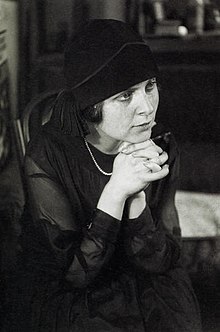Elsa Triolet
| Elsa Triolet | |
|---|---|
 |
|
| Born | Ella Kagan 24 September 1896 Moscow, Russian Empire |
| Died | 16 June 1970 Moulin de Villeneuve, Saint-Arnoult-en-Yvelines, France |
| Occupation | writer |
| Nationality | Russian, then French |
| Ethnicity | Jewish |
| Notable awards | Prix Goncourt 1944 |
| Partner | André Triolet, Louis Aragon |
| Relatives | Lilya Brik |
Elsa Triolet (24 September [O.S. 12 September] 1896 – 16 June 1970), born Ella Yurievna Kagan (Russian: Элла Юрьевна Каган), was a Russian-French writer.
Ella Kagan was born into a Jewish family of a lawyer and a music teacher in Moscow. She and her sister Lilya Brik received excellent educations; they were able to speak fluent German and French and play the piano. Ella graduated from the Moscow Institute of Architecture.
Ella enjoyed poetry and in 1915 befriended and fell in love with the aspiring futurist poet and graphic artist Vladimir Mayakovsky. When she invited him home, the poet fell madly in love with her older sister Lilya, who was married to Osip Brik. Ella was the first to translate Mayakovsky's poetry (as well as volumes of other Russian-language poetry) to French.
In 1918, at the outset of the Russian Civil War, Ella married the French cavalry officer André Triolet and emigrated to France, where she changed her name to Elsa, but for years admitted in her letters to Lilya to being heartbroken. She later divorced Triolet.
In the early 1920s, Elsa described her visit to Tahiti in her letters to Victor Shklovsky, who subsequently showed them to Maxim Gorky. Gorky suggested that the author should consider a literary career. The 1925 book In Tahiti, written in Russian and published in Leningrad, was based on these letters. She published two further novels in Russian, Wild Strawberry (1926) and Camouflage (1928), both published in Moscow.
...
Wikipedia
